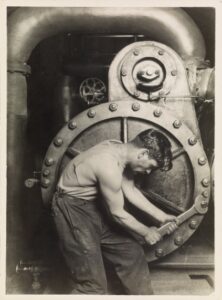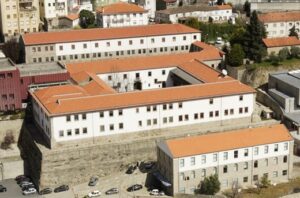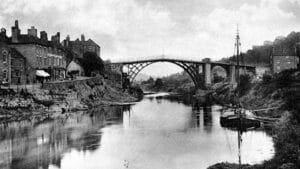There has been a lot of debate recently about industrial heritage and its importance. It is a prominent resource in the tourism market, and in fact, it is a heritage that has been left to us in order to understand a certain period in the life of society.
Today’s article explores the importance of industrial heritage, the challenges of safeguarding it and presents some notable examples in Portugal and around the world.
By Vanessa Miranda - author of the E-book Guide to Preservation of Cultural Heritage

What is industrial heritage?
Quite simply, industrial heritage refers to traces of industrial culture that emerged after the Industrial Revolution of the mid-18th century.
Concerns about protecting this type of heritage arose in England at the end of the Second World War.
What happened was that, at the end of the 20th century, after the services economy overtook factory production, the de-industrialization of this industry, which until then had been forgotten, began to raise interest among experts.
The factory complexes, the machinery and even the photographic records left a need in people’s memories to value a heritage that had marked so much an era.

In fact, industrial heritage helps us understand an era in the late 19th and early 20th centuries that was strongly marked by a process of industrialization and, consequently, by the material traces that reflect this phenomenon.
What are the material traces of industrial heritage?
As the name suggests, industrial heritage is made up of all the traces that were (and are) part of the manufacturing industry. We are talking about
- Buildings
- Machinery
- Workshops
- Factories
- Mines, processing and refining sites
- Warehouses and storage facilities
- Energy production, transmission and use centers
- Means of transportation and all their adjacent structures and infrastructures
- Places where social activities related to the industry took place, namely housing, places of worship or education

The importance of industrial heritage
As mentioned earlier, deindustrialization had consequences: it led to the abandonment of factory complexes and some notable examples of industrial architecture.
This abandonment and destruction triggered the first studies and surveys of this heritage in order to guarantee its safeguarding and protection.
In some southern European countries, industrial heritage was one of the last to be categorized as heritage for two reasons. On the one hand, because industrialization was late compared to the rest of Europe. On the other hand, the devaluation of industrial areas by the population and the degradation of the areas led them to be considered abandoned places, generating political, social and economic conflicts.
Testimony of technological and social transformation
In this sense, the appreciation of industrial heritage is very important, as it offers a unique perspective on technological evolution and the transformation of societies.
Factories and all the components associated with industrialization represent an important milestone in the history of economic development, showing how it has shaped the landscape of urban and rural landscapes.
Educational vehicle
In addition, the protection of this heritage serves as a vehicle for education, since it is possible to learn and teach future generations about the production methods and working conditions of past eras.
This knowledge is crucial to understanding the foundations of the contemporary world and the social changes that have taken place.
Testimony to human creativity
Another point that must be taken into account in the importance of industrial heritage is the capacity for human creativity employed. Industrial heritage is a true testament to people’s creativity, reflected not only in technological advances, but also in adaptations to conditions.
It is therefore a reflection of local identities and local histories.
Challenges in safeguarding cultural heritage
Industrial cultural heritage must be seen as heritage, as it represents a certain time in history and is part of the collective memory. The challenges of safeguarding it have not been fully resolved, as no (or even few) countries have adopted general protection policies.
There is therefore an urgent need to rehabilitate structures and equipment in order to build a future for industrial heritage.
Françoise Choay even admitted in her book “Allegory of Heritage” that modernization is a great potential for heritage preservation. It’s not about giving it a new look, but adding new ideas through old vestiges. A perfect symbiosis.
Placing the vestiges of industrial heritage in the more modern world means ensuring their recovery and enhancing a heritage that has been left behind. This intervention is important because it creates jobs, improves conditions for residents and creates an attraction for tourism.
It is therefore clear that there is a need for surveys, inventories, studies and publicity to keep industrial heritage in people’s collective memory.
Industrial heritage in Portugal
Industrial heritage in Portugal was a late bloomer. It was recognized in 1980. And it wasn’t until 2001 that industrial cultural assets were covered by the Cultural Heritage Framework Law.
Let’s see what article 72 says “Development laws may establish forms of protection, and corresponding regimes, especially applicable to cultural assets or to certain types of elements that make up the archaeological, archival, audio-visual, bibliographic, phonographic or photographic heritage or to new types of cultural assets, namely those that make up the electronic heritage or the industrial heritage.”
And article 2 “The relevant cultural interest, namely historical, paleontological, archaeological, architectural, linguistic, documentary, artistic, ethnographic, scientific, social, industrial or technical, of the assets that make up the cultural heritage will reflect values of memory, antiquity, authenticity, originality, rarity, uniqueness or exemplarity.”
Example of Industrial heritage in Portugal – Royal Textile Factory
In ancient times, wool was worked in Covilhã. But it was with the emergence of the Royal Textile Factory, one of the oldest examples of industry in the country, that the region’s economic development took off.
The Royal Textile Factory was founded in 1764 by King José I. Its creation was due to the policy of industrial growth promoted by the Marquis of Pombal.
The Royal Factory was created to help local manufacturers, especially in terms of organizing and carrying out dyeing and finishing operations. It also served to certify production quality and functioned as a school for orphaned and abandoned children.
The building
The building consisted of four rectangular wings and its façades were topped by granite cornices and respected the characteristic Pombaline style of the time.
The Royal Textile Factory operated until 1822. Later, it served as a military facility until, years later, it closed for good.
Now, the old royal factories have given way to the Wool Museum of the University of Beira Interior. It’s a place that still preserves the machines, techniques and experiences of the people who used to make wool in Covilhã, considered one of the most interesting success stories in Portuguese industry.

Example of Industrial Heritage in the World
Internationally, industrial heritage is widely recognized and preserved. In England, the greatest example of industrial heritage is Ironbridge.
In England, the village of Ironbridge Gorge is an emblematic example. It is considered the cradle of the Industrial Revolution, and has several historic industrial structures, including the world’s first iron bridge, built in 1779.
Ironbridge Gorge is a UNESCO World Heritage Site and a symbol of industrial innovation.
The classification highlights the area’s unique contribution to the Industrial Revolution.

In conclusion
It is always important to reflect on the past of a particular place, because only in this way can you link the memory of that place with a new page of a local story that must be told.
The past is a guiding thread of knowledge and memories, which in the present provides a more meaningful future.
These industrial remains from the past tell stories and, as such, should be seen as fragments of value. Their rehabilitation, conservation and preservation should help reintegrate them into contemporary society.
This will ensure that future generations understand the foundations of a society and human creativity responsible for industrial progress.
Industrial heritage with its factories, machinery and infrastructure deserves to be celebrated and preserved, not just as vestiges of the past, but as the foundations of our collective identity and our future.
Suggested reading:
Nizhny Tagil Charter on industrial heritage – The International Committee for the Conservation of the Industrial Heritage -TICCIH
Download:

Vanessa Miranda
Telling and writing stories, that’s how I remember myself being all my life. I have a degree in Tourism Management and a Master’s degree in Cultural Heritage. This passion led me to create a small company of carefully planned tourist activities centered on the history of Lisbon and the often forgotten and underestimated history of women.
As well as walking tours of the city, I work as a content consultant in the development and production of tourist itinerary content for the Walkbox app. I write opinion articles for a newspaper in Madeira and another in Barcelos. Driven by values, I volunteer for an association where I take on the role of content creator and manager.
By the author:
Guide to Preservation of Cultural Heritage
Protecting heritage is essential not only to preserve it for future generations, but also to enrich lives and promote intercultural understanding and dialog.
Because if we humans don’t do it, who will?
This is the aim of the Guide to the Preservation of Cultural Heritage – to offer guidelines and reflections so that everyone can contribute to the protection and preservation of cultural heritage.

